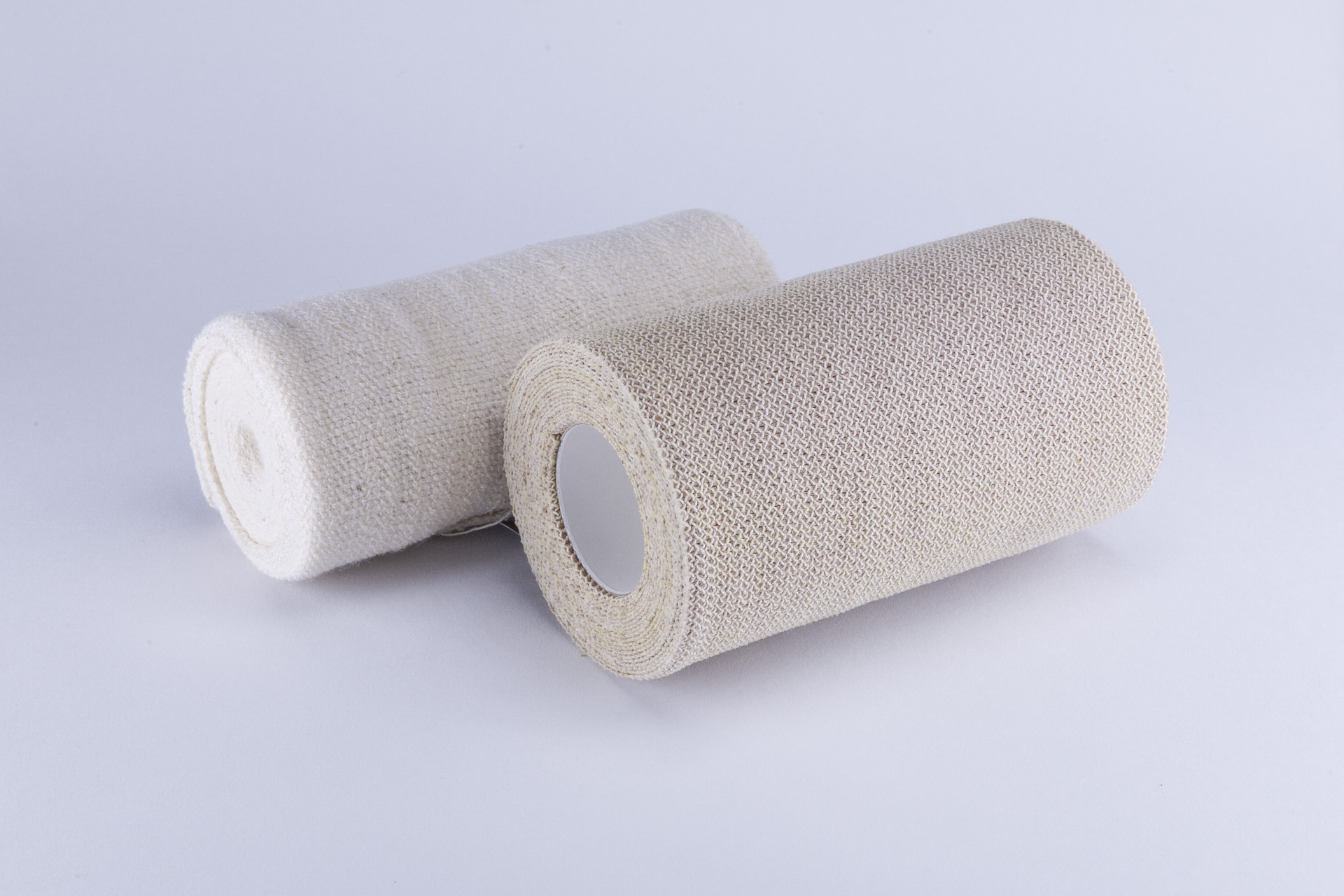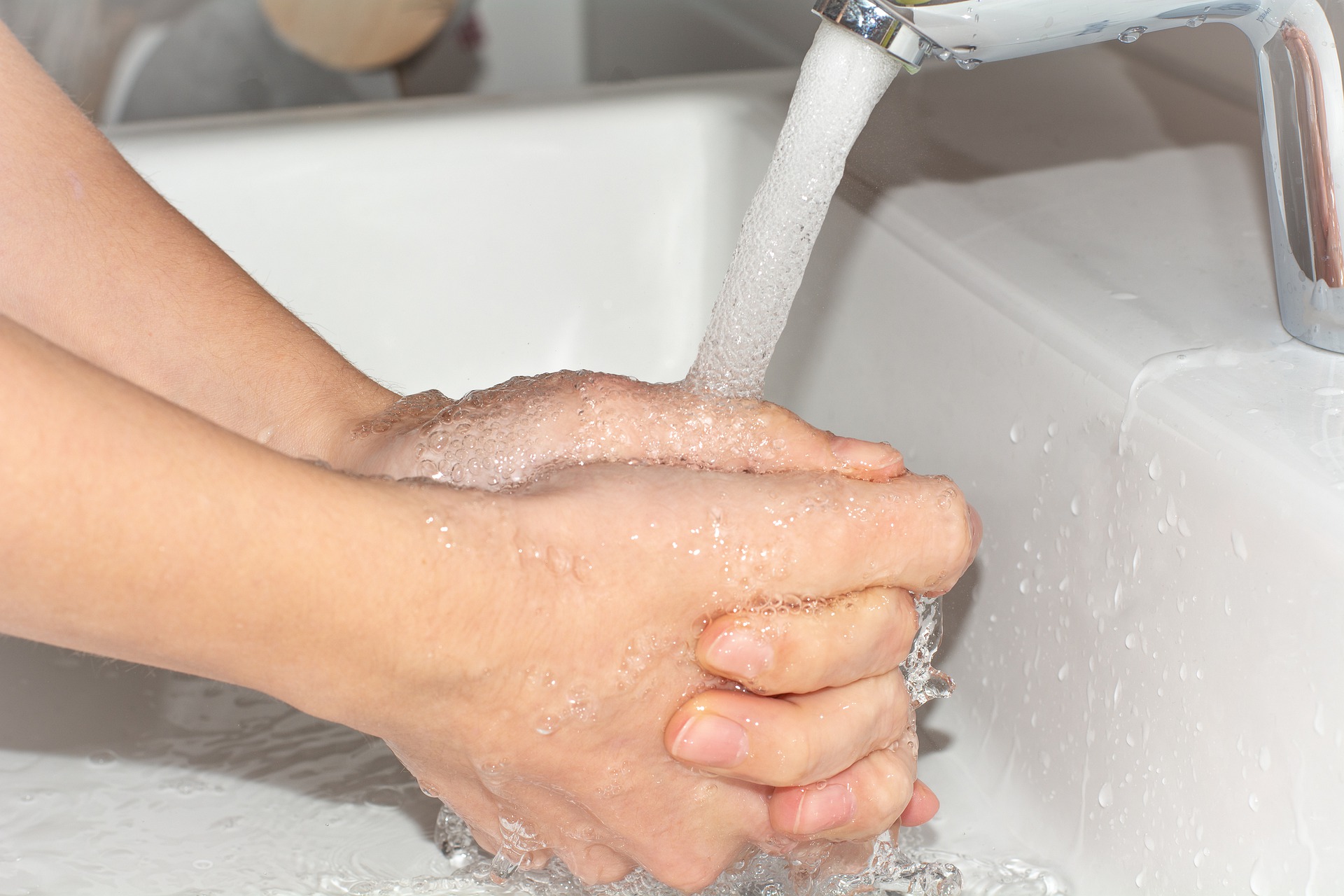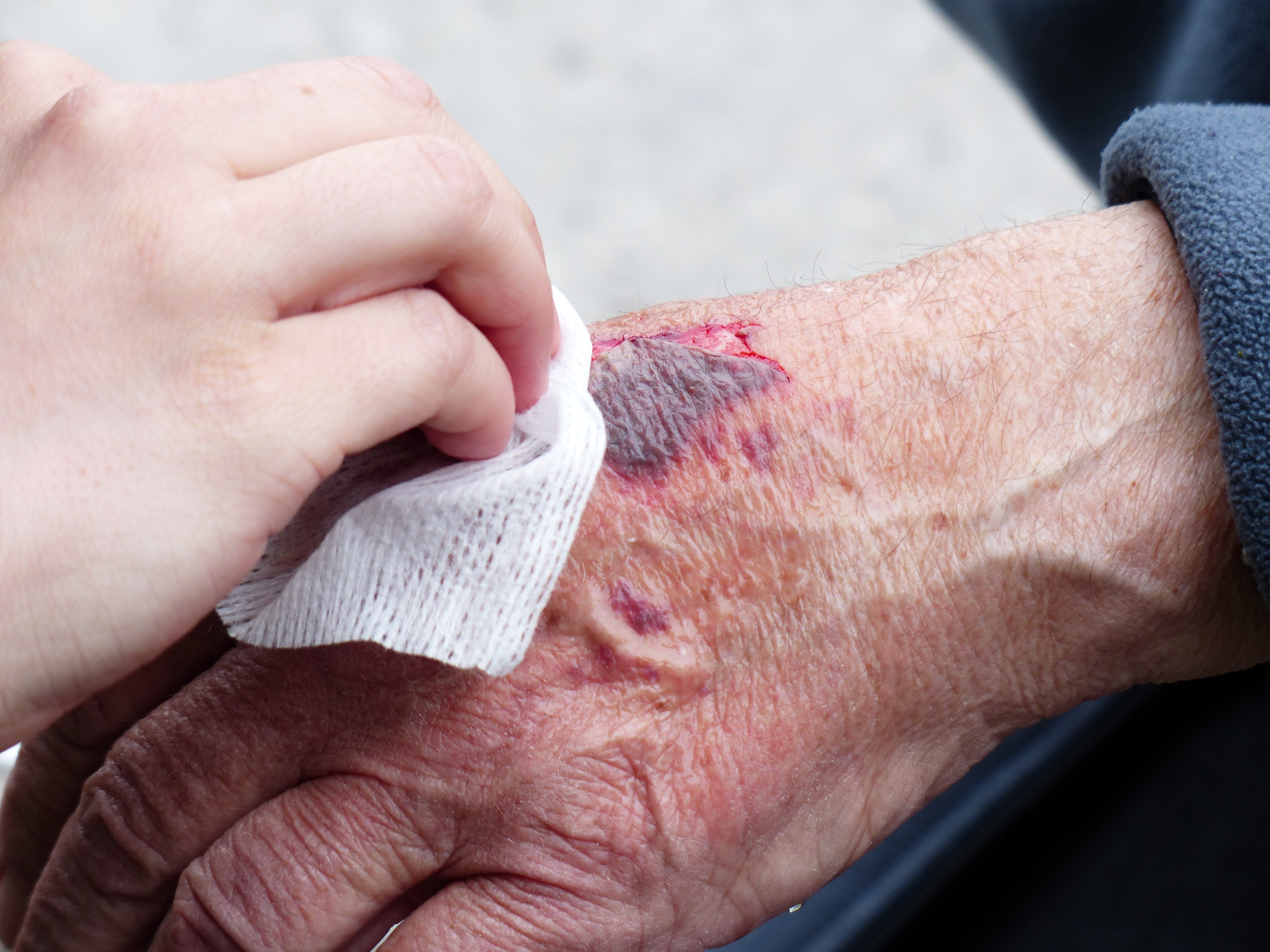The overarching aim of wound care is to provide the optimum conditions in which wound healing can take place – or in the case of chronic, non-healing wounds, to facilitate the most advantageous quality of life for the service user (Mallik et al., 2009). Wound care is constantly evolving and those involved in the care of service users with wounds must keep up to date with current developments.
Whenever wound care is carried out it is important to work within the guidelines and policies of your organisation, especially in relation to wound cleansing and the use of dressings. Tissue viability practitioners are an invaluable source of information and will be able to give you up-to-date advice on the appropriate care for each wound type. Your organisation may have a tissue viability practitioner; if this is so you may want to spend some time asking them about their role and the support they can offer to those caring for service users with wounds. With all wounds, if bleeding is present it should be controlled before the wound is cleaned and dressed.
Wound dressings
Before you move on to the final activity related to wound care, it is important to look at the use of wound dressings. The choice of wound dressing is dependent upon several factors, including:
- The type of wound.
- The location of the wound.
- Service user preference.
- Local guidelines.
An ideal dressing is one that:
- Is capable of promoting the healing environment; providing high humidity while removing excess exudate.
- Is free of particles and toxic wound contaminants.
- Is non-toxic and non-allergenic.
- Is capable of protecting the wound from further trauma.
- Can be removed without causing trauma to the wound (or surrounding skin).
- Is sterile and impermeable to bacteria.
- Is thermally insulating.
- Will allow gaseous exchange.
- Is comfortable and conformable.
- Requires only infrequent changes.
- Is cost-effective.
- Has a long shelf life.
(Jones et al., 2006, p. 777; Dhivya, Padma and Santhini, 2015)
An overview of the different types of dressings available is given in the BNF (see link)
https://bnf.nice.org.uk/wound-management/
Please access the paper by Anderson (2010) Key principles involved in applying and removing wound dressings. Nursing Standard. 25, 10, 51-57. which details different types of dressings:

Wound dressings
Wound dressings are often categorised as primary or secondary dressings. A primary dressing is applied directly to the wound, while secondary dressings secure the primary dressing in place and may provide protection to the wound or support the control of bleeding and oedema by providing pressure on the wound. The choice of wound dressings available to healthcare workers is bewildering and many organisations have specialist staff and guidelines to help staff select appropriate dressings for each wound type. Such guidelines often provide general advice on wound management as well as outlining the properties of different types of dressings and their uses.
Wound cleansing
Current thinking is that wounds should only be cleaned and dressed if absolutely necessary, as any superfluous intervention can delay wound healing (Lindholm and Searle, 2016; Beam, 2008). Cleansing chronic wounds is often unnecessary and is discouraged because of the damage it may cause to tissue; moreover, modern dressings maintain a moist environment that actually cleanses the wound. Cleansing is therefore only necessary when there is visible material to be removed mechanically, or to facilitate assessment.
Techniques used in wound care
The cleansing and dressing of wounds is undertaken using non-touch technique. Non-touch technique involves avoiding direct contact between the skin of one person, normally the hands, and an ‘at risk’ site on another person. The idea is to avoid contamination arising from the transfer of bacteria from the healthcare worker to the service user or vice versa. Non-touch technique acknowledges that, even with effective hand-washing, hands cannot be sterile. If a non-touch technique is used, the healthcare worker’s hands will not come into contact with the service user or with sterile equipment. Non-touch technique is usually used in procedures that require asepsis (freedom from infection) – for example, catheterisation, venepuncture, tracheal suction and wound care – and is often referred to as aseptic technique.
Application and selection of dressing type
Dressings often have a specialist application procedure, to ensure adherence and/or asepsis.
Infection control
Infection control impacts on the safe care of all service users.
Infection control is multidimensional, involving complex interactions between many aspects of care. In this unit you focus on the aspects of infection control that underpin safe practice. There is increasing concern over high rates of infection in care settings across the NHS, independent and voluntary sectors. Such infections are known as healthcare-associated infections (HCAIs), which have been described as:
Infections that occur as a result of contact with the healthcare system in its widest sense – from care provided in your own home, to general practice, nursing home care and care in acute hospitals. The term has recently been coined in recognition that increasingly complex procedures are undertaken outside hospitals. Previously, when most complex healthcare was hospital based, the term hospital acquired infection was used. Welsh Healthcare Associated Infection Programme, 2011.
Infections can have physical, social and psychological impacts on the service user and their carer. In addition, the financial cost to individuals in terms of personal income, and to care providers, can be astronomical – although some reduction in related costs has been achieved (NAO, 2009).
In this section, you will review the standard precautions that promote safe practice to protect both service users and staff. These include:
- Hand washing.
- The use of personal protective equipment, in particular, gloves and aprons.
- The environment (e.g. clinical setting or service user home).
You will also consider the physical systems that can prevent infection:
- Cleaning.
- Disinfection.
- Sterilisation.
You then consider a person who has contracted methicillin-resistant Staphylococcus aureus (MRSA) and the implications for their care. Finally, you consider aspects of standard precautions connected to the safe disposal of waste.
Why infection control is key
The cost to healthcare providers of infections runs into many millions of pounds, although initiatives in the UK since 2000 have significantly reduced the cost (Public Health England, 2019; National Audit Office, 2009). The issue of infection control is of such concern that policy development has been a focus of organisations at world, European and national levels. The World Health Organization (WHO) states that:
Infection prevention and control measures aim to ensure the protection of those who might be vulnerable to acquiring an infection both in the general community and while receiving care due to health problems, in a range of settings. The basic principle of infection prevention and control is hygiene. WHO, 2011a.
In response to the level of concern about the increasing incidence of the spread of infection, including within and across the more economically developed regions of the world, the WHO launched ‘Clean Care is Safer Care’ in 2005. This campaign promoted best hand hygiene practices around the world throughout healthcare provision, based on evidence clearly demonstrating hand hygiene as the primary measure in reducing HCAI and ensuring the safety of service users (WHO, 2011b). In 2015, WHO further evolved the initiative to the ‘Infection, Prevention and Control’ (IPC), focussing on patient safety and quality healthcare (WHO, 2020).
Government departments, national organisations and local organisations regularly produce policies and guidelines about the prevention of infections and cross-infection. To understand the factors that increase susceptibility to infection, consideration of the policy context alone is not sufficient. Many factors influence both individual and societal susceptibility to infection, including behavioural and cultural factors. In the remaining activities of this section you consider how these factors interact with individual lives and have an impact on the infections acquired by people.
Infection control in practice
This section provides brings this learning guide together for use in your practice. You will consider how to protect your service users, your colleagues and yourself. Many of the measures you explore will be familiar to you through your role, but this is an opportunity to take a fresh look at them.
The focus is on the physical systems that can be used to control infection. You will review standard precautions, especially hand washing and the use of personal protective equipment and clothing. You then consider how the physical processes of cleaning, disinfecting, sterilising and safe disposal of waste can reduce the risk of cross-infection.
Hand hygiene
The importance of good hand hygiene will already be familiar to you. The World Health Organisations’ 5 moments of hand hygiene are listed here as a refresher.
- Before touching a patient.
- Before clean/aseptic procedures.
- After body fluid exposure/risk.
- After touching a patient, and
- After touching patient surroundings.

PPE
Wearing appropriate personal protective clothing provides some protection. The next activity covers the personal protective equipment that, as part of standard precautions, protects you and service users. This equipment includes:
- Gloves.
- Aprons.
- Face-masks.
- Eye protection.
Cleaning is a physical process involving the use of detergent to remove visible signs of contamination (by blood or faeces, for example) both on equipment and in the environment. It also removes many micro-organisms and is an adequate method of decontamination for a wide range of equipment. You will probably have witnessed many examples of this method of preventing the spread of infection in your practice area as it is the most cost-effective means. National guidelines for preventing infections recommend that, when a piece of equipment is used for more than one person (such as movement and elimination aids), they must be cleaned after each use (Pratt et al., 2007).
Disinfection is a process that reduces the number of micro-organisms to a level at which they are not harmful. Spores are not usually destroyed and neither is the bacterium causing tuberculosis (Mycobacterium tuberculosis). A range of chemicals can be used for decontaminating skin, equipment and the environment. It is very important to check with your local policy to be certain that the method of disinfection is suitable for the intended purpose.
Sterilisation is defined as the destruction of all micro-organisms and their spores. Practice areas where there are vulnerable service users are likely to have greater numbers of sterilised items. This reflects the high risk to service users of acquiring infections when, for example, the body’s normal defence mechanisms are compromised due to long-term ill health (immune system issues) or surgery (breach of continuity of the skin).
The steam in autoclaves and the substances used for sterilisation and disinfection cannot penetrate blood, pus and other organic material, so instruments and other items must be carefully and thoroughly cleaned before sterilisation or disinfection. There are strict procedures and records in place to clean and monitor the autoclave machines, to ensure the equipment is fit for purpose. If you use this equipment, it is your responsibility to know when the machine was last checked and if it is safe to use (check the machines record).
The Health and Social Care Act 2008: Code of Practice for Health and Adult Social Care on the Prevention and Control of Infections and Related Guidance helps NHS bodies plan and implement how they prevent and control HCAIs (Department of Health, 2009). It states that there is a duty to provide and maintain a clean and appropriate environment for healthcare; the Department of Health has produced a set of benchmarks for the care environment in England and Wales through its Essence of Care initiative (2010). Scotland, Northern Ireland, the Republic of Ireland and the States of Jersey have similar guidance.
States of Jersey infection control policies are available via the Health Department intranet. Please contact your employer for access to them.
The physical methods of cleaning, disinfection and sterilisation afford service users and practitioners an important level of protection. Alongside the correct disposal of contaminated waste, these measures can help keep your working environment safe.
Isolation
Isolation is the ultimate infection control measure that can be used across a range of settings. There are two core situations in which isolation is used:
- To protect the service user.
- To protect those who need to come into close proximity to a person with an infection that could cause harm to others.
In the activity below, consider source isolation and protective isolation.
Source isolation aims to confine the infectious agent and prevent its spread. In contrast protective isolation is used to protect patients who are severely immunocompromised and are at a serious risk of infection.
Read the scenario below and answer the questions that follow.
Paula, a physiotherapy assistant, has come to assist Mr Glyndwr to mobilise. There is a sign on the door of Mr Glyndwr’s room: ‘Infection control precautions – visitors please report to a member of staff before entering the room.’ The member of staff informs Paula that Mr Glyndwr has a pressure ulcer and that he is MRSA-positive.
- Is Mr Glyndwr in source or protective isolation?
- What questions would Paula need to ask before she is able to carry out interventions with Mr Glyndwr (in terms of managing the infection risk and the pressure ulcer)?
- What do you think Mr Glyndwr’s concerns would be?
- What could Paula do to help Mr Glyndwr deal with his concerns?
- How can the potential negative effects of isolation be reduced?
Discussion
Mr Glyndwr is in source isolation as he has MRSA, which is spread in the same way as Staphylococcus aureus, mostly on the hands of staff who acquire the organism through direct contact with colonised or infected skin. Uniforms and equipment and the airborne route can also be implicated in spreading MRSA. For these reasons, it is common to isolate people such as Mr Glyndwr.
Paula may want to know more about how the pressure sore might affect Mr Glyndwr, and also what precautions she needs to take regarding the infection. She may need to ask whether it is acceptable to take Mr Glyndwr out of his room, and to find out what to do about the equipment she is bringing with her (this will depend on local policy). She may also need to know whether she should wear gloves and/or an apron while she is helping Mr Glyndwr.
Mr Glyndwr may be feeling isolated, lonely and worried. Some patients in source isolation become frustrated and bored and some describe feeling confined and imprisoned; some feel angry, neglected and insignificant. He may be worried about his visitors, wondering if there is any danger to them and how long this might go on for. He may be afraid that the pressure ulcer might not heal, or indeed that the infection might be life-threatening.
By anticipating Mr Glyndwr’s reactions and feelings Paula may be able to help him to voice his concerns and guide him towards the information that he needs. Paula can ask for advice from her supervisor and other staff.
You might have thought of providing a call bell for Mr Glyndwr. Spending time with him would improve his wellbeing and he could have a television and a radio to hand.
Waste disposal
Access the guidance your organisation provides on the safe disposal of waste, familiarising yourself with the colour coding system. Make a list of the different types of waste materials in your practice setting and observe the disposal of these waste materials. After carrying out your observations and making notes, answer the following questions:
- How are the waste materials from your practice setting disposed of?
- Are they disposed of in accordance with the colour coding system?
Discussion
All practitioners must comply with guidance on safe and appropriate disposal of waste.
Waste materials can be infectious or toxic so it is important to dispose of them in a systematic way to prevent harm and cross-infection to others. You have explored how the nationally agreed colour coding system for the safe disposal of various forms of waste operates in your practice setting.
Summary
This learning guide has provided you with an introduction and refresher to wound care and infection control procedures. You have considered procedures for wound cleansing and types of dressing. You then went on to review techniques applied in wound care, before refreshing your understanding of infection control issues. This learning guide also considered infection control in practice, reviewing hand hygiene, PPE, isolation and waste disposal procedures to enable you to deliver safe and effective wound care to your service user.




Rate and Review
Rate this article
Review this article
Log into OpenLearn to leave reviews and join in the conversation.
Article reviews